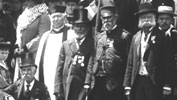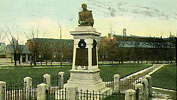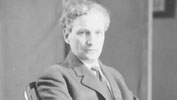|
On Saturday, January 5, 1907, 70 veterans and many citizens, led by Mayor Coatsworth, gathered in Victoria Memorial Square to unveil the “Old Soldier” by the young sculptor Walter Allward, a memorial commissioned by the Army and Navy Veterans’ Association to honour the dead of the War of 1812. It was the culmination of nearly 20 years of planning and fundraising.
The Garrison Cemetery, active since 1794, had closed in 1863. By the 1880’s its neglected condition and incidents of vandalism had become a matter of public note. In February of 1882 a farmer was observed driving away with headstones in his wagon (“The Globe”, Feb.23). The City in 1884 was concerned enough to establish a Military Burial Ground Commission to record and preserve its history and to tidy it up for use as a local park.
By 1888, however, the papers were reporting that “much remains to be done to make the square attractive”. The Army and Navy Veterans’ Association (ANVA) “already ... have decided to start subscription lists with the view of having a handsome monument erected ... And last Saturday [July 14] ... some of the officers ... paid a visit ... to see what could be and what ought to be done there” (“The Globe”, July 17, 1888).
Progress was slow. In 1895 further loss of gravestones was reported, including that of Simcoe’s daughter, “ ... in place a couple of months back”. In February, 1899 ANVA asks the City to give care of the park to a veteran “to preserve headstones and other relics”, and in March a grant of $100 is voted for a monument. At the ANVA annual service in May 1900, the sermon includes an appeal to raise the monument — “ ... it should be a sacred duty of the citizens to put up some memorial stone at this historic spot”. A reference is made to there being “more than 800 graves (“The Globe”, May 21, 1900).
By 1901 the monument has momentum. It is announced that Frank Darling, architect “has been commissioned to prepare the design for the soldiers [sic] monument to be erected in Portland Square.” (Canadian Architect and Builder xiv, April 1901, p.86) and plans are made to have the visiting Duke and Duchess of Cornwall and York attend the laying of the cornerstone. Grants from the three levels of government appear to be promised, and a further appeal made to citizens for funds (“The Globe”, April 15 and June 29, 1901).
In April, 1901 ANVA asks the Toronto Guild of Civic Art (TGCA) to take charge of the competition for an artist to design the monument. TGCA appoints a committee comosed of Byron (later Sir Edmond) Walker, Wyly Grier, James Mavor, William Cruickshank and Frank Darling (convener). (TRL, Baldwin Room, TGCA Minute Book). A call for design proposals to be submitted by September is printed, but no other records of this process have been discovered to date.
On July 1, 1902, too late for the visiting royalty, ANVA lays the cornerstone. A photograph of the event shows the maquette of the pedestal and a drawing of a full-length military figure surmounting it. The crowd is addressed by, amongst many others, the Mayor and Alexander Muir (“The Globe”, July 2, 1902).
Later in the year, on Saturday, November 22, the unveiling of the pedestal itself is presided over by the Premier, George W. Ross and attended by representatives of all the regiments involved in the War of 1812, and some later conflicts (“The Globe”, November 24, 1902). A later reference indicates that nine coffins had been found on the pedestal site (“The Globe”, January 7, 1907).
The first mention [so far] of the artist selected is made in 1905. The City budget includes $600 for a “granite bust of a soldier in the uniform of 1812 by Walter Allward the well-known sculptor” (The Globe”, May 20, 1905).
On January 5, 1907, the long awaited monument was unveiled. Praise was immediate:
“The monument ... is in the form of a half-length figure, and of the artistic qualities of this distinguished piece of work one can speak only in terms of the highest praise. The indomitable courage of a fine British type is depicted by Mr. Alward [sic] with a reverent hand, and the horror of war is made to reach the consciousness through the poignant pathos of the aged and broken veteran. The medal upon the breast is one made for George IV, but which for some reason remained unused until our late beloved Queen ... commanded that it should be cast and distributed among those who had fought in the War of 1812 ... In this effort Mr. Alward has but added fresh laurels to his name and there can be nothing but praise for the breadth of treatment – the simple strength and depth of sentiment in the rugged figure”. (Alexandrine Ramsay, “The Globe”, January 5, 1907, Illustrated Section)
Later comments:
“To see the Old Soldier one must make an excursion into a slum of Toronto, a shabby little park or base-ball ground called Portland Square ... here indeed is a little neglected shrine of art. For the half figure of a soldier, with his empty coat sleeve and his eager, wonderful old face is absolutely haunting ... In this bit of comparatively early work, Mr. Allward gets right away from so-called “portrait study”, or a Victorian symbolism which would depict by the conventional figure of a veteran in uniform the idea of patriotism, to something vital and real”. (Katherine Hale, “The Canadian Magazine”, January, 1919, pp77-78)
“Perhaps the first figure to show [Allward’s] latent power of symbolism was that done for the Army and Navy Veterans’ Association in commemoration of the War of 1812. This little known and neglected statue stands in Portland Square, Toronto. It is a half-length figure of an old soldier whose empty coat-sleeve and wistful face is full of suggestion.” (O.J. Stevenson, “A People’s Best” 1927, p33)[ top ]
“Walter Allward (1876-1955) was probably Canada’s most important monumental sculptor in the first third of [the 20th] century. Born in Toronto, he first worked as a draughtsman for an architectural firm and subsequently modeled terra cotta decorative panels for the Don Valley Brick Company. His first commission was for the figure of Peace for the North West Rebellion Monument at Queen’s Park, Toronto in 1894. While he later received commissions for portrait monuments (the Simcoe Monument (1896?-1903), Sir Oliver Mowat (1899?-1905) and J.S. Macdonald (1907-1909), all at Queen’s Park), his preference was for more allegorical interpretations as evidenced in his South African War Memorial (1904-1910) on University Avenue in Toronto and the Baldwin-Lafontaine Monument (1907-1914) on Parliament Hill in Ottawa. Yet his most notable early success was the Alexander Graham Bell Monument (1908-1917) in Brantford, Ontario. In 1912 he was awarded the contract for the King Edward VII memorial in Ottawa of which only two figures, Truth and Justice, were cast in 1923 and which are now installed in front of the Supreme Court in Ottawa. The most important commission Allward received was for the monument to Canadians killed in the First World War at Vimy, France, a project which would occupy him from 1921 to its unveiling in 1936 on the eve of the Second World War.”
(National Gallery of Canada, “Walter S. Allward Collection Finding Aid”)
At its meeting in November 2001, the Historic Sites and Monuments Board of Canada recommended that Walter Allward be designated as a National Historic Person. The Board’s Statement of Significance reads:
“He was an outstanding Canadian sculptor in the first quarter of the twentieth century and a dominant figure in the transition from late 19th century monumental sculpture in the Beaux-Arts style to the modern abstract sculpture that emerged after the Second World War;
His many Canadian monuments are a lasting testament to his original sense of spatial composition, his mastery of the classical form and his brilliant craftsmanship; and
The Vimy Monument is a masterpiece of Canadian monumental sculpture.”
Additional notes:
Frank Darling was one of the three judges on an international panel which selected Allward for the Vimy Memorial project.
[Revised draft: July, 2005, RSJ]
|
|

Unveiling of cornerstone, July 1, 1902

Veterans' monument.
Postcard c1910

Walter Allward
Photo: M.O. Hammond 1913
Arts and Letters Club of Toronto
|